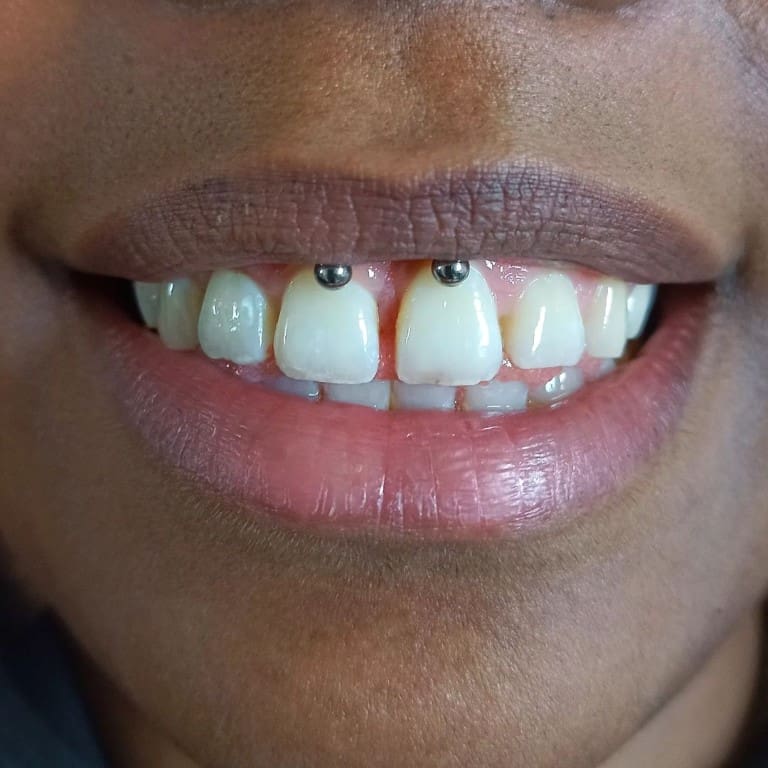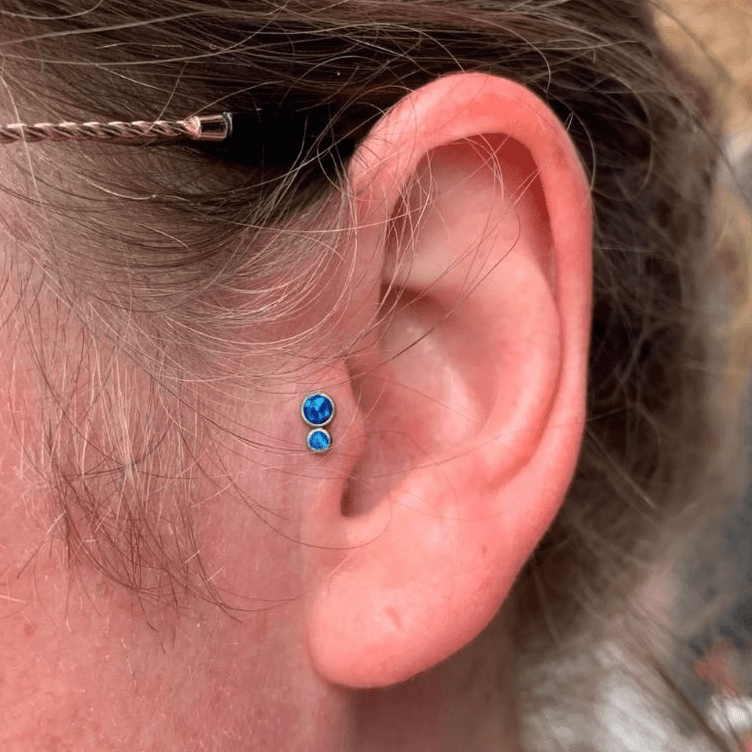Are you looking for an unusual yet trendy body jewelry? If so, you might want to look into getting the smiley piercing. This oral piercing goes through the tissue that connects the inside of your upper lip to your upper gums.
What makes the smiley special is that the captive bead ring, seamless ring or horeshoe ring stays nicely hidden as long as you don’t smile. Everytime u smile u get to show it off!
Read on to learn everything you need to know about this ‘new’ piercing. Do you have any unanswered questions? Feel free to leave a comment in the comment section below.
Table of Contents
History of the smiley or frenulum piercing
The first references of piercings in the frenulum inside the mouth date from the late nillies, and have become very popular in the U.S. in the last couple of years.
Not only in the U.S. though, it’s somewhat of a worldwide ‘trend’. Not a big one, but definitely an existing one.
The placement of the scrumper
When you are getting your frenulum piercing, the needle goes through the upper flap (also called: the frenulum) in your mouth that ensures the connection between your upper lip and your gums. There is also a lower frenulum by the way, and yes there is a frowny piercing too. The official term for the smiley piercing is ‘lip frenulum piercing‘.
Not everyone has it!
Before you hype yourself up for this new piercing you’re probably already planning to get, assuming by you reading this: make sure you have the proper anatomy for it first!
Not everyone has a thick enough web up there, some people don’t even have it at all. Save yourself the disappointment and check your anatomy beforehand.
In order to find your upper frenulum, this is what you need to do:
Go stand in front of a mirror.
Push your upper lip up- and outwards, curling it up.
Look for the thin piece of skin that connects the inside of your lip to your gum line. It should be centered right above your two front teeth.
If you can’t find it, we’re sorry to disappoint you friend…
What will the piercer do? The procedure explained
Consultation
The first and most important thing your piercer should do, is inform you about the risks and con’s! In the case that they don’t do that, we recommend you find another piercer.
Finding reputable piercers
The first thing you need to look out for, is whether or not the piercer informs you by themselves about the risks. If you ask them questions and you try to understand, analyse their answers. Are they short and do they try to enlighten you, or are they just reassuring you with ‘Don’t worry about it’?
If so, they’re probably more concerned with you paying them instead of your wellbeing.
Oh, and something very important to keep in mind: if you see piercing guns laying around or if they bring out one instead of a needle. Run. Run and never return!
The Procedure of getting it done: piercing process
The piercer will then check if it is possible to pierce your frenulum. If it’s too thin or too small, it may tear after piercing. Keep in mind that if you have braces, a smiley piercing may not be possible, it depends. If your smiley does get pierced, you’ll feel a sharp pain and a burning sensation.
Now they should ask you to fill in a consent form to check for any issues that may come up.
Next, if you are still on board your piercer will ask you to hold your lip up, just like you did before in front of the mirror. That is when the piercer is going to clean your frenulum and dry it out with some clean sterile swabs.
Following, they are going to mark the entrance and the exit hole. You will have to take a deep breath in and they’re going to pierce you once you exhale. Some piercers might use a clamp, but others might freehand it.
Once the jewelry is in, the piercing procedure is complete and your new piercing is now a fact. You get to go home and enjoy your smiley piercing!
Avoid infection: piercing aftercare and healing process
Thanks to the antibacterial properties of your saliva, an oral piercing like this heals quickly. The healing time generally takes about up to 1 – 2 months until the healing process is complete. If the smiley was pierced through some deeper, thicker tissue it can take a bit longer than that to heal.
Proper aftercare will make sure that your smiley piercing healing process doesn’t get prolonged.
Warm-sea-salt water or saline solution rinses are a MUST!
Rinse your mouth with the saline solution at least twice a day for the first few weeks.
You should also rinse your mouth with a biotene antiseptic mouthwash. Aswell as brushing your teeth with a mild toothpaste.
Stay away from smoking, alcohol, hot & spicy foods, acid-based food (e.g. tomato sauce), salty foods and beverages.
Unless you want your healing time to be prolonged, of course.
Do not play with your piercing with your tongue and do not try to move it. This can also cause damage to your teeth enamel.
Take me as an example guys. Both times I had mine I couldn’t keep it in for more than 6 months, because of me not being able to stop playing with it. So, try to not fidget!
The more you move it around and eat ‘complicated’ foods, the more likely you are to experience swelling. Trust us, you do not want that.
After your piercing has been completely healed, clean your new gem with a small toothbrush to avoid plaque build-up.
More things to be mindful of
With a fresh frenulum piercing, as with any other oral piercing, the risk of sexually transmitted diseases such as HIV and hepatitis is hightened! So one more thing to take care of: the practise of safe sex! Avoiding any unnecessary oral activities would be the best. You can survive without french kissing for a few weeks! Or even better, get your scrumper while you’re still single, saves you troubles later on.
This said, you should also stay away from sharing food or beverages. Eat only from your own plate, drink from your own glass and don’t bite from anyone else’s food. Avoid cross-contamination and harmful bacteria will not bother your smiley piercing.
Apart from that, avoid putting any unclean and unhygienic objects in your mouth. Toothpicks, dirty cutlery, pens, etc… Your immune system is already weakened by this new jewelry in your mouth, don’t test it by putting objects that should not be there. Starting with a new, fresh toothbrush is also recommended.
This piercing, more than others that go through thicker skin tend to be a bit more touchy-feely to migration so it is prone to growing out, a.k.a. rejection.
Even once fully healed, if agitated, the smiley face piercing can tend to swell. It’s in such a position that it’s almost never left alone. You’re constantly talking and eating, if not, you’re moving your mouth (yawning, smiling, laughing, etc…); and if you are anything like me, your tongue will constantly want to fidget with it. If it swells though, it can expand so much so you’d struggle taking it out and the piercer you go to for help will despise you.
So take care of your oral health and oral hygiene and try to keep it just at soft foods for the first few weeks.
On the flip side, some pro's
Despite all of the ”problems” we listed above, it is generally not problematic. If you take good care of it and always keep an eye on it, that is! Its history tells us that it heals reasonably well. It’s been around for ages so it is not a new, extreme nor experimental piercing. We know it heals.
It is however not a very common piercing. Even with all the online talks, trends and hypes around it, it stays a very unusual piercing. Unlike other piercings, you don’t come across the smiley piercing as often.
”It goes through these stages of 6 months, everybody and their brother wants one. And then you don’t hear about them for years.” – DaVo
It also won’t affect eating and speech like some other oral piercings tend to do.
Another benifit of the smiley piercing is the fact that it can be hidden! More about this further down.
Smiley piercing jewelry options
Most people go for a horseshoe (the ring with the 2 hanging piercing balls), also known as a circular barbell. Just a regular ring is also a common choice.
There are also curved barbells. They look like banana-shaped horseshoe rings. Straight barbells can also be placed for smiley piercings. Those will hide your piercing completeley even when you smile. However, we do not recommend you to ask for/use those.
If you want to avoid enamel and upper gum damage, gum disease, stay away and stick to a circular barbell or a ring. There are also rings with only one small bead, centered.
Or if you want to spice it up, the vampire smiley piercing has been getting some attention aswell. Thanks to an adjusted circular/curved barbell with spikes instead of beads, anyone can now get their own set of smiley piercing fangs! Where was this both times I had my smiley piercing? So you see, there are plenty of smiley piercing jewelry options you can go for without having to purposefully damage your gums.
If you’re planning on keeping your smiley piercing for as long as you can, the best recommendation we can give you is to wear light-weight, captive ‘nose’-type rings. Those should keep you away from migration and rejection for a longer period of time than other jewelry.
Material-wise, make sure your piercer uses (surgical) titanium or at least surgical stainless steel for the initial jewelry! It has to be a hypoallergenic material. Surgical steel is the cheapest and safest option, but titanium is better.
Gold and silver jewelry are also an option IF you are not allergic to nickel, because even the smallest amounts of it can cause a reaction.
Whatever you do, just ensure that the person who will be piercing you does not use low quality jewels and that they ask you about any allergies. And, they should always be either in a sterile packaging or be disinfected in an autoclave. I don’t think anyone is up for an allergic reaction because they didn’t go to a professional piercer.
The risks
” If you have a metal object constantly in contact with your front teeth, it is gonna do damage to your front teeth!” – David ‘DaVo’ Wilkins, the owner and operator of the Axiom Body Piercing studio
David ‘DaVo’ Wilkins has been piercing since 1994, so he’s got quite the experience. Not only that, but he’s also a major advocate when it comes to doing things the professional way. He’s one to be trusted.
Just like any other oral piercings or lip piercings, if the smiley piercing is constantly rubbing against your gums it WILL cause gum recession.
This is the reason we do not recommend curved nor straight barbell jewelry! Those are the types of jewelry that will cause damage the fastest.
It can also be a concern for your teeth and bone structure of your mouth. With time, there will be enamel impairment.
Having the innocent looking small smiley piercing for long periods of time will do that. That’s why this is NOT or at least shouldn’t be, a permanent piercing! We don’t think anyone wants gum and enamel damage.
It is a piercing that is generally okay for 1 to 3 years at a time. Personally, both times I had it, I kept it for 6 months maximum before I started seeing indents/irritation on my gums. A lot of other people I’ve heard from however, have been able to keep it for 3, even 4 years without any problems. It all depends. That’s why you’ll need to check up on your gums and teeth from time to time.
That being said, as we’ve already stated, those are not reasons to keep you away from getting the smiley piercing. These are things you’ll have to keep in mind if you want to get a smiley piercing.
FAQ
Yes, there is still a needle going through a body part of yours. It is a body modification.
However, compared to other piercings, most people report it being less painful.
This depends from person to person. However, we can tell you that compared to for example, cartilage piercings or any other piercings, it is not painful.
The smiley piercing is an oral piercing.
Summed up: gum recession and teeth enamel destruction.
An infected smiley piercing is usually very sore if not painful, excessively swollen, red and it usually doesn’t smell all that good. Discharge can also be a sign of infection.
This depends from piercer to piercer, and studio to studio. It can be anywhere between $30 up to $80 or even higher, depending on the region and person you go to.
Yes and no. It all depends on the placement and the type of jewelry of your smiley piercing.
Smiley piercings that are placed more on the lower side, will be more likely ro rub against your teeth. On the long term that can damage the enamel and if no actions are being taken, it can cause further damage. This is why piercers generally don’t recommend keeping this piercings for more than 3 years at a time.
Thanks to the antibacterial properties of your saliva, an oral piercing like this heals quickly. The healing time generally takes about up to 1 – 2 months until the healing process is complete. If the smiley was pierced through some deeper, thicker tissue it can take a bit longer than that to heal.





